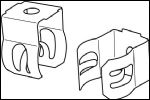Since the ahj has the ultimate say (assuming no court dates are involved), it is at some point up to the inspectors to dispense with contractors who lack common sense or try to skate on thin ice. It is clearly the intent (and conspicously stated) of the code to NOT be a design manual. Its clear that part of the reason for that is that it is so hard to simply write a working code for what it intends to cover. So at some point either the engineer on record (by virtue of the specifications for the job), the architect, the electrical contractor, or the inspector must decide what will work and what won't. Hopefully the electrical contractor, being a responsible master and tradesman, will determine a suitable attachment method prior to or during installation of the product, or if necessary obtain the information necessary from a reliable source, or consult with the professionals on the job, or even the ahj.
What is a suitable attachment method and what is not will continue to change from year to year, and from jurisdiction to jurisdiction, and with new technologies that evolve. So it is a common sense approach to electrical installations to forego the notion that every nut, bolt and wire must be specified by the code, and imshio its a good thing.


